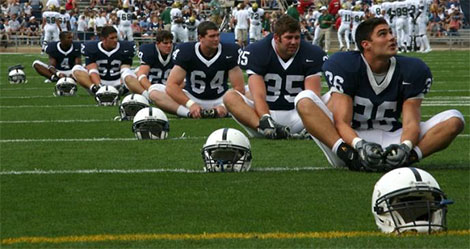Football is more than just fun and games. While young fans admire their favorite football athletes on ESPN, the full-contact plays are also causing an astounding increase of unique injuries across the nation.

According to U.S. Consumer Product Safety Commission:
- The 2009 football season saw over 1.2 million football-related injuries;
- Such injuries resulted in more than $2.8 billion total medical costs from treatments in hospitals, doctor’s offices, and emergency rooms.
“Traumatic injuries to the knee and shoulder as well as concussions are the most common types of injuries we see on both the professional and youth levels,” said orthopaedic surgeon Matthew Matava, MD, team physician for the St. Louis Rams and spokesperson for the STOP Sports Injuries campaign and the American Academy of Orthopaedic Surgeons (AAOS). “Overuse injuries, especially in the beginning of the season are another big issue with kids pushing themselves too far and too fast without proper conditioning.”
The STOP Sports Injuries Campaign, which works to expose the growing epidemic of youth sports injuries related to overuse and trauma was launched in spring 2010. Leading healthcare organizations have joined forces for STOP, including the American Orthopaedic Society for Sports Medicine (AOSSM), the American Academy of Orthopaedic Surgeons (AAOS), the American Academy of Pediatrics (AAP), National Athletic Trainers’ Association (NATA), National Strength and Conditioning Association, American Medical Society for Sports Medicine, Sports Physical Therapy Section and SAFE Kids USA .
Because many football injuries can be prevented, the AOSSM and AAOS encourage the following easy strategies for parents, coaches and athletes:
- Have a pre-season health and wellness evaluation to determine ability to participate
- Warm-up properly with low-impact exercises like jogging that gradually increase heart rate
- Consistently incorporate strength training and stretching. A good stretch involves not going beyond the point of resistance and should be held for 10-12 seconds
- Hydrate adequately to maintain health and minimize cramps
- Play multiple positions and/or sports during the off-season to minimize overuse injuries
- Wear properly fitted protective equipment, such as a helmet, pads, shoes and mouthguard. Do not modify equipment.
- Tackle with the head up and do not lead with the helmet
- Cool-down properly to gradually lower heart rate with exercises like light jogging.
- Don’t play through the pain. Speak with an orthopaedic surgeon who specializes in sports medicine or athletic trainer if you have any concerns about injuries or tips on injury prevention.
Concussions in football are another serious concern and could have long-term health and mental ramifications. “Having coaches, parents and athletes know the symptoms of a concussion, is critical and could save lives,” said Matava. Concussion symptoms include:
- Balance problems
- Difficulty communicating, concentrating
- Dizziness
- Drowsiness
- Fatigue
- Feeling mentally foggy
- Headache
- Irritability
- Sleeping more than usual or not as much as usual
- Visual problems
If you recognize these symptoms in an athlete, seek treatment from a certified athletic trainer or physician immediately.
For more information on football injury treatment and prevention, visit www.STOPSportsInjuries.org or www.orthoinfo.org.
